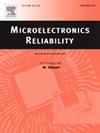A NBTI self-healing circuit for a 12 nm CMOS high-gain amplifier
IF 1.6
4区 工程技术
Q3 ENGINEERING, ELECTRICAL & ELECTRONIC
引用次数: 0
Abstract
This paper presents a self-healing circuit for a 12 nm CMOS high-gain amplifier which can mitigate the degeneration of NBTI effects. Based on an 12 nm P-FinFET NBTI equivalent circuit model, the degeneration of a high gain amplifier under NBTI stress has been simulated. The DC-gain will degrade from 107.5 dB to 80.6 dB after 10 years NBTI stress. A monitoring circuit has been utilized to indirectly detect the degeneration degree of the input transconductance and DC-gain, and then compensate it through a bias circuit and an input transistors replacement circuit. The simulation results show that the input transconductance and DC-gain of the amplifier with the self-healing circuit will decrease about 0.01uS and 0.09 dB at 25 °C after 10 years of NBTI stress. Further corner simulations show that the lifespan of the amplifier with the self-healing circuit will be >20 years under NBTI stress.
一种用于12nm CMOS高增益放大器的NBTI自愈电路
本文提出了一种用于12nm CMOS高增益放大器的自愈电路,可以减轻NBTI效应的退化。基于12 nm P-FinFET NBTI等效电路模型,模拟了NBTI应力作用下高增益放大器的退化。经过10年NBTI应力后,直流增益从107.5 dB下降到80.6 dB。利用监测电路间接检测输入跨导和直流增益的退化程度,并通过偏置电路和输入晶体管替换电路对其进行补偿。仿真结果表明,采用自愈电路的放大器在25℃下经过10年NBTI应力处理后,输入跨导和直流增益分别降低了0.01uS和0.09 dB。进一步的拐角模拟表明,在NBTI应力下,带有自愈电路的放大器的寿命将达到20年。
本文章由计算机程序翻译,如有差异,请以英文原文为准。
求助全文
约1分钟内获得全文
求助全文
来源期刊

Microelectronics Reliability
工程技术-工程:电子与电气
CiteScore
3.30
自引率
12.50%
发文量
342
审稿时长
68 days
期刊介绍:
Microelectronics Reliability, is dedicated to disseminating the latest research results and related information on the reliability of microelectronic devices, circuits and systems, from materials, process and manufacturing, to design, testing and operation. The coverage of the journal includes the following topics: measurement, understanding and analysis; evaluation and prediction; modelling and simulation; methodologies and mitigation. Papers which combine reliability with other important areas of microelectronics engineering, such as design, fabrication, integration, testing, and field operation will also be welcome, and practical papers reporting case studies in the field and specific application domains are particularly encouraged.
Most accepted papers will be published as Research Papers, describing significant advances and completed work. Papers reviewing important developing topics of general interest may be accepted for publication as Review Papers. Urgent communications of a more preliminary nature and short reports on completed practical work of current interest may be considered for publication as Research Notes. All contributions are subject to peer review by leading experts in the field.
 求助内容:
求助内容: 应助结果提醒方式:
应助结果提醒方式:


